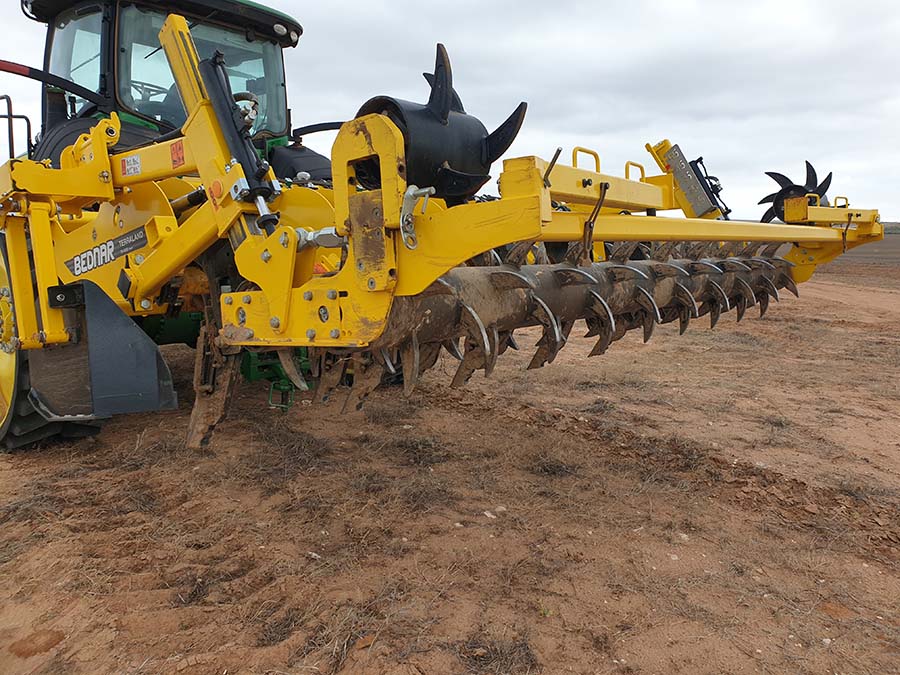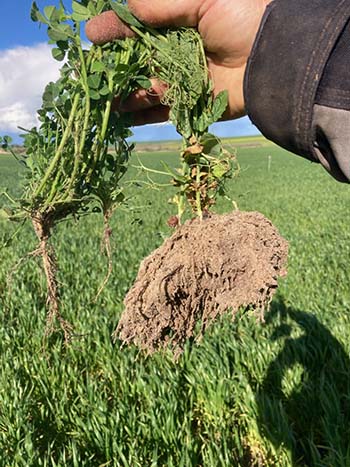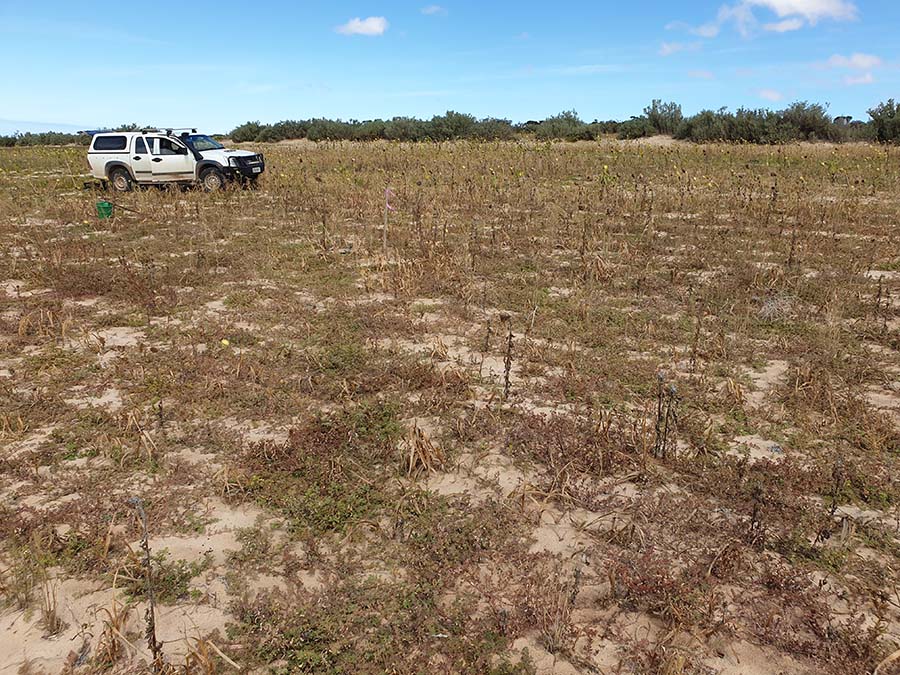Snapshot
Grower: Ben Ranford
Location: Cleve, Eyre Peninsula, South Australia
Farm size: 3000 Ha
Enterprise: Continuous cropping
Growing season rainfall: 330mm annual and 250mm growing season
Soil type: Non-wetting sands over clay through to sandy loam flats
Cropping program: 50% cereal, 40% pulses/canola/vetch, 10% mixed species
Seeding system: No-till farming, stripper and conventional header front. Tobin disc seeder.
Ben Ranford farms with his family at Cleve on the Eyre Peninsula. The area has an average annual rainfall of 330mm, with 250mm on average falling in the growing season. Their soils include some white non-wetting sands over clay but are mainly sandy loam. They generally work on a cereal and legume rotation, mainly lentils on the flats and vetch or field peas on the sandy rises, with canola also used in more promising seasons.
Ben finds that their sands are low in nitrogen, so legumes are essential in supporting soil carbon and biological activity. He uses a legume dominant mixed species green manure over about 10% of the farm each year.
Managing subsoil constraints
Throughout 2017 to 2020 the area suffered from challenging dry periods and damaging winds during critical growing season windows. The Ranford's have no livestock in their system, although they have still suffered some erosion damage on their sandy rises. To overcome these issues and protect their white sands, Ben has been deep ripping and delving while growing and returning crop residues to the soil, in addition to the use of other soil health improvement strategies.
Deep ripping, delving and mixing
The 2018 season was very dry and exceptionally windy on Eastern Eyre Peninsula. It was particularly difficult to get crops established on non-wetting sands. Areas of sandy soil with low levels of cover were severely affected by wind erosion. The hostile growing conditions restricted opportunities to establish cover so a decision to deep rip the sand was made in late 2018. Ben’s primary objective was to disturb the smooth sweeping surface and bring clay up from the subsoil to help stabilise the sand. Longer term objectives were to improve the sand texture and structure with clay and organic matter plus overcome compaction and water repellence.
Deep ripper
In 2018, Ben initially used a 3-point linkage Yeoman’s deep ripper which had narrow vertical tynes at 500mm spacing. The maximum working depth was about 600mm. Inclusion plates were fitted to each tyne to allow topsoil to fall down behind the tynes to a depth of about 300mm. This approach was effective in disturbing the surface and overcoming any compaction layers, but it was not designed to delve clay up. The clay subsoil was also very dry and hard, so it was difficult to penetrate. The inclusion plates had limited benefit because there was not much organic matter to take down deeper. Where there was lengthy residue (rye straw or melons), blockages were an issue.
Growing plant cover
In Autumn 2019, it was a high priority for Ben to sow cereal rye early on all bare sand areas. Ripped areas were very soft with deep furrows and ridges (main image) and moisture levels across the top soil were uneven due to runoff on ridges. This uneven, soft soil made sowing difficult. To overcome this, Ben found it helped to sow at a 15 degree offset to rip lines. Much of the area was sown with two passes in different directions. This resulted in good plant establishment.
In December 2019, some rye on the sandy sites was harvested with a stripper front. This left tall ground cover to protect the soil surface. In March 2020, prior to delving, the rye stubble was cut low with a conventional header front, going through the harvester chopper and back onto the ground. This eliminated residue blockages while delving and allowed better mixing of crop residue into the soil.
Delving
In Autumn 2020 Ben purchased a 3-point linkage Bednar Terraland which has delving angled tynes at 500mm spacing. The tynes have 200mm wide plates mounted on the front to enhance subsoil lifting. These also hold soil out from behind the tyne, creating a similar opportunity for surface layers to fall down the profile as an inclusion plate. Behind the tynes are a pair of spikey, rolling harrows which mix and level the soil. The maximum working depth is about 500mm. Ben has found the Bednar to be an ideal machine for his situation. On most sandy areas, his clay is within half a metre of the surface and within reach. If the clay was any deeper, he would need to consider a different delver.

Bednar machine with rolling harrows and delving tines. Photo: Supplied.
Improving soil from both directions
Ben’s approach in 2020 achieved the objectives of adding clay to the top 30cm of soil while allowing some residue and water repellent sand to be mixed into the low organic matter sub soil. The addition of aggressive, heavy harrows mixed the components together and left a dimpled but level surface. This combination greatly improved wetting of the seed bed. The newly renovated soil was still very soft, so a pass with a steel land roller was needed before seeding in April. Ben did this immediately before sowing to reduce exposure to wind erosion. Rolling smudged out clay lumps which improved soil mixing. Seeding into areas prepared in this way was much easier than the previous approach.

Bednar results mixing delved clay from below and rye stubble from above. Photo: Supplied.
Avoiding future compaction
Controlled traffichas been a feature of Ben’s zero-till approach to cropping and this is considered even more important on the renovated sand. The steel roller and disc seeder are both 12m and other machines are based on this width. Operations will stick to the established run lines.
The right time to delve?
In Ben’s “Mallee” environment, late Summer and Autumn are a practical time to undertake sandy soil renovation. There are no other competing cropping operations, and it is close to seeding which minimises the time the area will be bare and prone to erosion. The renovated soil will only be stabilised when it is covered with plant growth so getting something planted immediately following delving is ideal. Delving brings moist soil to the surface and offers this opportunity. Ben’s goal is to have seeding added to the back of the Bednar to achieve this in a single pass. Ben would also like to green manure diverse cover mixes (eg: vetch, barley and brassicas) with the Bednar in spring before sowing warm season cover species. He thinks this would improve soil organic matter and biological activity even faster.
“Delving or ripping are slow operations, so it is really about deciding when you need to have the job finished and work back from there. If bringing up clay is an important component, it is critical that the clay has enough moisture in it for a tyne to penetrate - dry clay is like concrete!” Ben says.
Improving the fertility of the poor sands
Ben uses a mixture of granular fertiliser and his own carbon/humate-based liquid brew to boost plant growth and soil biological activity. He finds that growing a diverse combination of plants together stabilises soil better compared to a single crop type.

Side-by-side plant root comparisons of medic (L) vs field pea (R). Photo: Supplied.
Ben also sees value in blending cover-cropping techniques into his farming system.
He occasionally sows a mix of brassicas, legumes and cereals to increase the soil's biological diversity.
Ben is careful only to use herbicides that he deems are less harmful to soil dynamics, tolerating some weeds in preference to chemicals that could restrict plant growth.
When he gets good summer rainfall, he will immediately sow a mix of sunflower, millet, peas and vetch, which protects the soil and increases soil biological activity.
This approach is ideal for harvested legume areas. To optimise the benefits of these summer covers, they are terminated by the end of January to preserve soil moisture for the winter crop.
Ben is increasing soil microbiology (fungi and bacteria) and macro-fauna (ants, termites, earthworms etc.) across all of his soil types.
This is evidenced by increased soil aggregation and observable insect, grub and general digging activity within soils, including sands.
Successfil rehabilitation

Ben's mixed species plantings to increase biological diversity over a longer growth period.
Rehabilitated sands from 2018 blowout areas showed very safe soil cover of at least 50-70% from March 2021 to May 2022, with excellent surface dry aggregations of 30-60%. Ben attributes this to minimal soil disturbance, strong cereal rye growth, the active encouragement of soil biota and increased clay content in the topsoil. Areas briefly exposed to soil mixing after the Bednar pass were soon covered by crop, protecting from erosion risks.
While Ben is always seeking to learn more and improve his farming systems, he is confident that the systems he now has in place are working well and he has successfully rehabilitated all eroded areas. His soils are now more productive and more likely to support better plant growth due to his amelioration strategies.
Read: Cropping land restoration and the lessons following successive years of drought in NSW.

























































